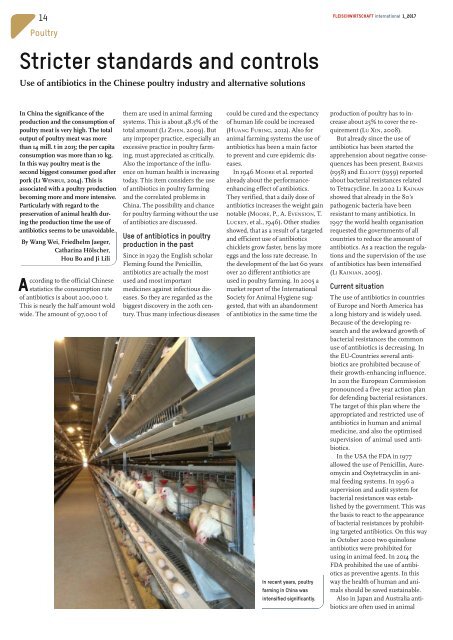FLEISCHWIRTSCHAFT international 1/2017
Create successful ePaper yourself
Turn your PDF publications into a flip-book with our unique Google optimized e-Paper software.
14<br />
Fleischwirtschaft <strong>international</strong> 1_<strong>2017</strong><br />
Poultry<br />
Stricter standards and controls<br />
Use of antibiotics in the Chinese poultry industry and alternative solutions<br />
In China the significance of the<br />
production and the consumption of<br />
poultry meat is very high. The total<br />
output of poultry meat was more<br />
than 14 mill. tin2013; the percapita<br />
consumption was more than 10 kg.<br />
In this way poultry meat is the<br />
second biggest consumer good after<br />
pork (LI WENRUI,2014). This is<br />
associated with apoultry production<br />
becoming more and more intensive.<br />
Particularly with regard to the<br />
preservation of animal health during<br />
the production time the use of<br />
antibiotics seems to be unavoidable.<br />
By Wang Wei, FriedhelmJaeger,<br />
Catharina Hölscher,<br />
HouBoand Ji Lili<br />
According to the official Chinese<br />
statistics the consumption rate<br />
of antibiotics is about 200,000 t.<br />
This is nearly the half amount wold<br />
wide. Theamount of 97,000 tof<br />
them are used in animal farming<br />
systems. This is about 48.5% of the<br />
total amount (LI ZHEN,2009). But<br />
anyimproper practice, especially an<br />
excessive practice in poultry farming,<br />
must appreciated as critically.<br />
Also the importance of the influence<br />
on human health is increasing<br />
today.This item considers the use<br />
of antibiotics in poultry farming<br />
and the correlated problems in<br />
China. Thepossibility and chance<br />
for poultry farming without the use<br />
of antibiotics are discussed.<br />
Use of antibiotics in poultry<br />
production in the past<br />
Since in 1929 the English scholar<br />
Fleming found the Penicillin,<br />
antibiotics are actually the most<br />
used and most important<br />
medicines against infectious diseases.<br />
So theyare regarded as the<br />
biggest discovery in the 20th century.Thus<br />
manyinfectious diseases<br />
could be cured andthe expectancy<br />
of human life could be increased<br />
(HUANG FUBING,2012). Also for<br />
animal farming systems the use of<br />
antibiotics has been amain factor<br />
to prevent and cure epidemic diseases.<br />
In 1946 MOORE et al. reported<br />
already about the performanceenhancing<br />
effectofantibiotics.<br />
They verified, that adaily dose of<br />
antibiotics increases the weight gain<br />
notable (MOORE,P., A. EVENSION,T.<br />
LUCKEY,etal., 1946). Other studies<br />
showed, that as aresult of atargeted<br />
and efficient use of antibiotics<br />
chicklets grow faster,hens lay more<br />
eggs and the loss ratedecrease. In<br />
the development of the last 60 years<br />
over 20 different antibiotics are<br />
used in poultry farming. In 2005 a<br />
market report of the International<br />
Society for Animal Hygiene suggested,<br />
that with an abandonment<br />
of antibiotics in the same time the<br />
In recent years, poultry<br />
farming in China was<br />
intensified significantly.<br />
production of poultry has to increase<br />
about 25% to cover the requirement<br />
(LU XIN,2008).<br />
Butalready since the use of<br />
antibiotics has been started the<br />
apprehension about negative consequences<br />
has been present.BARNES<br />
(1958) and ELLIOTT (1959) reported<br />
about bacterial resistances related<br />
to Tetracycline. In 2002 LI KAINAN<br />
showed that already in the 80’s<br />
pathogenic bacteria have been<br />
resistant to manyantibiotics.In<br />
1997 the world health organisation<br />
requested the governments of all<br />
countries to reduce the amount of<br />
antibiotics. As areaction the regulations<br />
and the supervision of the use<br />
of antibiotics has been intensified<br />
(LI KAINIAN,2005).<br />
Current situation<br />
Theuse of antibiotics in countries<br />
of Europeand North America has<br />
along history and is widely used.<br />
Because of the developing research<br />
and the awkward growth of<br />
bacterial resistances the common<br />
use of antibiotics is decreasing. In<br />
the EU-Countries several antibiotics<br />
are prohibited because of<br />
their growth-enhancing influence.<br />
In 2011 the European Commission<br />
pronounced afive year action plan<br />
for defending bacterial resistances.<br />
Thetarget of this plan where the<br />
appropriated and restricteduse of<br />
antibiotics in human and animal<br />
medicine, and also the optimised<br />
supervision of animal used antibiotics.<br />
In the USA the FDAin1977<br />
allowed the use of Penicillin, Aureomycin<br />
and Oxytetracyclin in animal<br />
feeding systems. In 1996 a<br />
supervision and audit system for<br />
bacterial resistances was established<br />
by the government.This was<br />
the basis to reacttothe appearance<br />
of bacterial resistances by prohibiting<br />
targeted antibiotics. On this way<br />
in October2000 twoquinolone<br />
antibiotics were prohibited for<br />
using in animal feed. In 2014 the<br />
FDAprohibited the use of antibiotics<br />
as preventive agents. In this<br />
way the health of human and animals<br />
should be savedsustainable.<br />
Also in Japan and Australia antibiotics<br />
are often used in animal

















